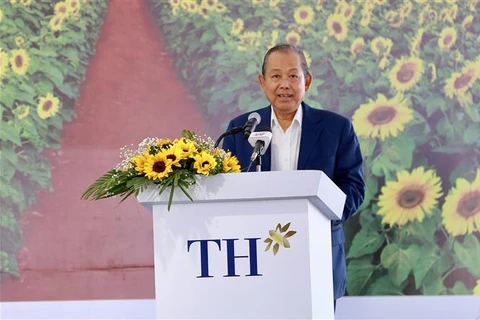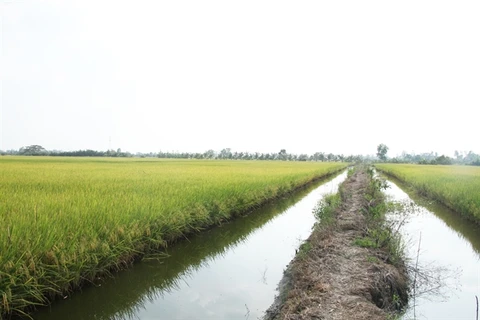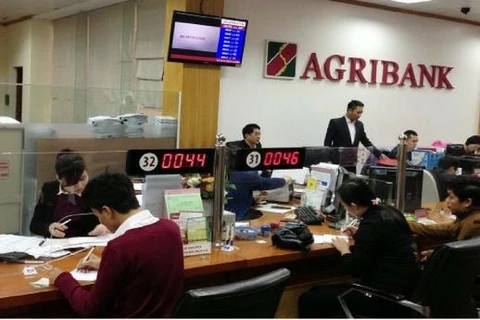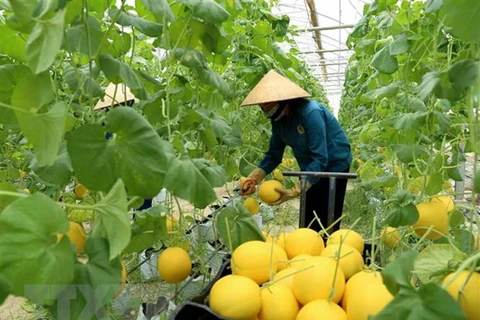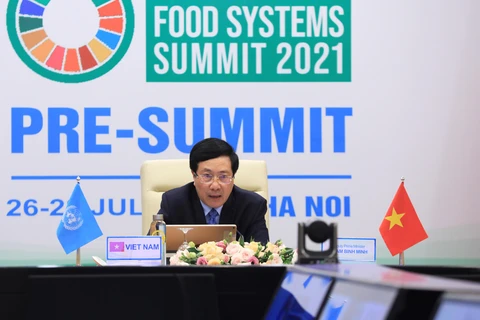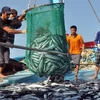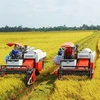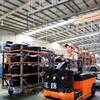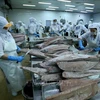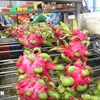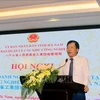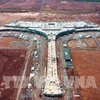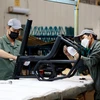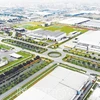Hanoi (VNA) – Applying digital technology into agriculture help achieve fast and sustainable development is a goal that the northern province of Vinh Phuc is aiming at.
The national digital transformation programme until 2025, with a vision to 2030, identifies agriculture as one of the eight priority fields.
Accordingly, digital transformation in agriculture will focus on developing smart agriculture and precision agriculture while raising the proportion of digital agriculture in the economy.
Farm produce’s value increases thanks to digital transformation
Since late 2018, Van Hoi Xanh, a vegetable production cooperative in Tam Duong district, has applied the VietGAP software, helping it be free from manually keeping production diaries and only need to check updated data via a computer or a smartphone.
The software has made it easier for the cooperative to monitor the use of input materials like seeds, fertilisers, and plant protection substances by its members. Besides, Van Hoi Xanh has also digitalised marketing and product selling activities.
Thanks to technology application, its vegetable output has increased by 5 - 10 percent from the past, supplying tens of tonnes of safe vegetables for the market each month.
Since 2019, Binh Minh livestock farming cooperative in Lap Thach district has spent billions of VND on upgrading and building its farming system and cooperated with some smallholders to produce clean pork under VietGAP standards, becoming the first cooperative in Vinh Phuc province to apply a circular livestock farming model.
Mac Tuan Hai, director of the cooperative, said using old farming practices, it costs farms much to hire labourers or buy feed and medicine.
When high technology is applied, each pig is numbered and monitored via e-diary. Traders can also watch via the camera system to select and purchase pigs, he noted.
Digital transformation key to developing hi-tech agriculture
The outcomes that some businesses and cooperatives in Vinh Phuc province have obtained demonstrate that digital transformation is an important key helping farmers produce agricultural products at the lowest possible costs but sell at the highest possible prices.
To create prerequisites for digital transformation in agriculture, relevant agencies in the province have proactively built database about local agriculture, forestry, and fishery; worked to apply scientific - technological advances into the sector; and advised provincial leaders about mechanisms and policies assisting agricultural firms in this regard.
Vinh Phuc is currently home to many fruit, vegetable, and livestock farming zones meeting the VietGAP standards. Many of them have gathered in production chains, thus raising production value per each hectare of farming and successfully exporting several products like red-fleshed dragon fruit, banana, and bee honey to foreign markets.
However, the provincial Department of Agriculture and Rural Development also admitted that technology application and digital transformation in Vinh Phuc remain modest, and that traditional cultivation practices that primarily rely on human labour are still popular.
The target of digital transformation in agriculture is the people, which in turn are both the beneficiary and player of digital transformation. However, it will be hard to secure success if farmers are left alone during this process, but mechanisms, policies, resources, and support from authorities and enterprises are necessary, the department said.
Applying digital technology into agriculture
Basing on the national digital transformation programme, Vinh Phuc has issued special policies to encourage investment in agriculture and rural areas during the 2020 - 2025period.
It is set to gradually apply digital technology into production and business processes, along with the management and monitoring of supply chains.
In the short term, it is supporting investment in production zones of safe pork, vegetables, fruits, and flowers under VietGAP standards; helping farmers make use of technology to grow the crops and livestock that Vinh Phuc has strength in; and providing training for and transferring sci-technological advances to farmers, thus gradually forming supply chains.
Local authorities expect these moves will help the province develop hi-tech farming zones, promote trade, and advertise local agricultural products to the domestic and foreign markets./.
The national digital transformation programme until 2025, with a vision to 2030, identifies agriculture as one of the eight priority fields.
Accordingly, digital transformation in agriculture will focus on developing smart agriculture and precision agriculture while raising the proportion of digital agriculture in the economy.
Farm produce’s value increases thanks to digital transformation
Since late 2018, Van Hoi Xanh, a vegetable production cooperative in Tam Duong district, has applied the VietGAP software, helping it be free from manually keeping production diaries and only need to check updated data via a computer or a smartphone.
The software has made it easier for the cooperative to monitor the use of input materials like seeds, fertilisers, and plant protection substances by its members. Besides, Van Hoi Xanh has also digitalised marketing and product selling activities.
Thanks to technology application, its vegetable output has increased by 5 - 10 percent from the past, supplying tens of tonnes of safe vegetables for the market each month.
Since 2019, Binh Minh livestock farming cooperative in Lap Thach district has spent billions of VND on upgrading and building its farming system and cooperated with some smallholders to produce clean pork under VietGAP standards, becoming the first cooperative in Vinh Phuc province to apply a circular livestock farming model.
Mac Tuan Hai, director of the cooperative, said using old farming practices, it costs farms much to hire labourers or buy feed and medicine.
When high technology is applied, each pig is numbered and monitored via e-diary. Traders can also watch via the camera system to select and purchase pigs, he noted.
Digital transformation key to developing hi-tech agriculture
The outcomes that some businesses and cooperatives in Vinh Phuc province have obtained demonstrate that digital transformation is an important key helping farmers produce agricultural products at the lowest possible costs but sell at the highest possible prices.
To create prerequisites for digital transformation in agriculture, relevant agencies in the province have proactively built database about local agriculture, forestry, and fishery; worked to apply scientific - technological advances into the sector; and advised provincial leaders about mechanisms and policies assisting agricultural firms in this regard.
Vinh Phuc is currently home to many fruit, vegetable, and livestock farming zones meeting the VietGAP standards. Many of them have gathered in production chains, thus raising production value per each hectare of farming and successfully exporting several products like red-fleshed dragon fruit, banana, and bee honey to foreign markets.
However, the provincial Department of Agriculture and Rural Development also admitted that technology application and digital transformation in Vinh Phuc remain modest, and that traditional cultivation practices that primarily rely on human labour are still popular.
The target of digital transformation in agriculture is the people, which in turn are both the beneficiary and player of digital transformation. However, it will be hard to secure success if farmers are left alone during this process, but mechanisms, policies, resources, and support from authorities and enterprises are necessary, the department said.
Applying digital technology into agriculture
Basing on the national digital transformation programme, Vinh Phuc has issued special policies to encourage investment in agriculture and rural areas during the 2020 - 2025period.
It is set to gradually apply digital technology into production and business processes, along with the management and monitoring of supply chains.
In the short term, it is supporting investment in production zones of safe pork, vegetables, fruits, and flowers under VietGAP standards; helping farmers make use of technology to grow the crops and livestock that Vinh Phuc has strength in; and providing training for and transferring sci-technological advances to farmers, thus gradually forming supply chains.
Local authorities expect these moves will help the province develop hi-tech farming zones, promote trade, and advertise local agricultural products to the domestic and foreign markets./.
VNA

